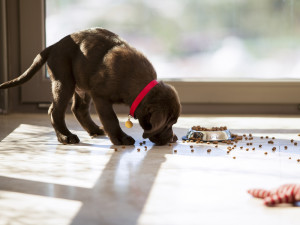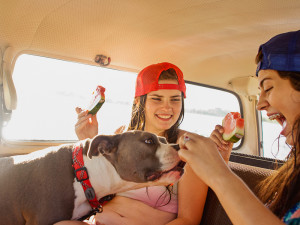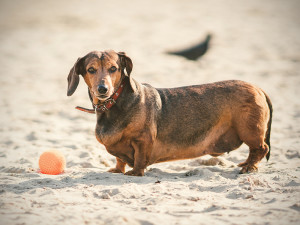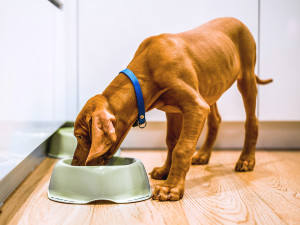How Many Treats Is Too Many?
The key to curbing mindless snacking — this is for your dog.
Understanding how many treats you can give your dog is critical — too many treats risk obesity or other health issues. Consider the following tips to determine if you need to adjust your dog's treat intake.
Step One: Monitor Your Dog’s Health.
Monitor your dog’s body condition score every month. Stand above and behind your dog, observing waist taper, rib prominence, belly tuck, and profile silhouette. An expanding midsection and loss of definition signals a few too many treats.
Step Two: Weigh Your Dog.
Weigh them regularly on your home or vet scales. Rapid weight gain exceeding expected growth averages or steadily increasing body weight often indicates excess calorie intake.
Step Three: Factor Treats Into Their Diet.
Consider treats an integral part of their diet — remember, as little as 10% to 20% extra calories can profoundly impact their waistline. Audit how many treats they receive daily and cut back if exceeding the recommended caloric intake.
Step Four: Examine Stool Consistency.
Loose stools or gastro issues can arise from too many treats interfering with digestion or overwhelming the pancreas’ insulin production.
Step Five: Provide Low-calorie Alternatives.
Replace half of their treats with low or zero-calorie alternatives like bits of carrots, green beans, ice cubes, plain air-popped popcorn, or low-sodium vegetable broth ice cubes.
Step Six: Follow This Rule of Thumb.
For training purposes, two to four tiny, pea-sized daily treats are appropriate for a dog at a healthy weight. Remember, the mental stimulation of receiving something is as rewarding as the treat itself, so your dog won’t feel like they are missing out.
How many treats per day for a dog?
The bulk of your dog’s calories should come from their regular food, which is designed to meet their nutritional needs. Dog treats should only be used as rewards for good behavior and make up no more than 10% of your dog’s daily calories. So, for example, if you have a small dog that needs 400 calories a day, and the treats you give them are 20 calories each, then they can have two of them per day. It takes a little math.
As you can see, the key to this equation is knowing a) how many calories your dog should eat, and b) how many calories are in the treats you choose to give. Information found on your dog food label, along with a conversation with your veterinarian, will guide you to that number. And any commercially prepared dog treats will list the calories-per-treat on the package.
What about dog training treats?
Dr. Elizabeth Shines, DVM, breaks it down: “Generally speaking, dogs that are at a healthy weight for their breed can have two to four appropriately-sized treats per day.” If you’re a new pet parent, you’re probably thinking, By my calculation, it will take an eternity for my puppy to learn how to sit! Indeed, you’re bound to go through far more dog training treats in the first year of your pup’s life.
“Treats designed for dog training are usually given in greater quantities, so they tend to be very small and low in calories,” says Dr. Shines. “Unless you’re doing multiple training sessions per day, those treats are unlikely to make a significant impact on your dog.�”
To keep bagged training treats fresh — and make it a little more difficult for the diligent treat-hound to score — keep the bags sealed. If the seal doesn’t work (often they don’t), use heavy-duty zip lock–type bags or store them in glass or ceramic containers with tight-fitting lids.
Low-calorie alternatives to dog treats
Not all treats share the same number of calories, so get in the habit of reading labels and adjusting your dog’s intake accordingly. “You can also consider using your dog’s kibble as a treat. Just set aside a portion of their meals and use it to reward them throughout the day. Kibble is typically lower in calories than treats, and most dogs won’t notice the difference between that and an actual treat. But if your dog is onto you, you can buy a different type of kibble and use that to make the treats more exciting for them. And don’t forget that dental chews like Greenies are much higher in calories, so you will need to account for them.”
Then there’s people food. The food we eat tends to be higher in fat, and those calories can add up quickly for dogs. Take peanut butter, for example. Just one tablespoon can equal 25% of a small dog’s daily calories. And cheese is even higher in calories: one ounce can account for more than 30% of a little dog’s daily target. If you want to share the snacks you’ve already got in the fridge, look for options that are lower in calories. Dr. Shines suggests white-meat chicken, turkey, or vegetables including baby carrots, peas, and green beans.
Think healthy treats: Look for organic, whole-food ingredients, including named meats, whole grains, lots of good fruit and/or vegetables and natural, food-based sweeteners (if they are used at all) —applesauce, honey, or molasses, for example. Avoid by-products, artificial coloring, artificial flavoring, and artificial preservatives. Look for individual portions that are easy to break into smaller bits.
Keep an eye on your dog’s weight
Calorie counting aside, you’ll want to monitor your dog’s weight and adjust if they start to pack on the pounds. The best methods are to put your pup on a scale or use your hands to assess their body condition. “There are a few things to look for when evaluating your dog’s body condition,” says Dr. Shines. “When a dog is at a healthy weight, you’ll be able to feel their ribs. You should also be able to feel the abdominal tuck, where the belly slants up into the groin. And when running your hands over the waist, most dogs should have an indention between the last rib and the hips.”
“If you start to notice changes in your dog’s body condition, cut back on calories [‘weight control’ dog treats can help],” Dr. Shines adds. “And talk to your veterinarian so you can nip any weight gain issues in the bud.” Remember that rewards aren’t always edible — “Good boy!” goes a long way.










